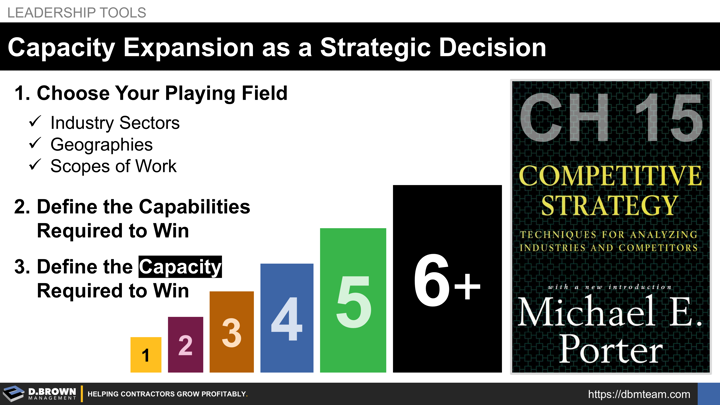Strategy is an evolving body of knowledge. If there were perfect answers, strategy would be a commodity rather than a differentiator. Given the high-level of fragmentation in the construction industry, along with the wide range of scale and outcomes between contractors, it is obvious that neither strategy nor execution is a commodity in the industry.
- How do your financial outcomes compare to industry benchmarks?
- How does your company's scale and growth compare to others?
The best thing you can do as a leader within a construction company is study the growing body of knowledge around strategy and execution. Study your environment, both inside your company and externally. Then make the best strategic decisions you can and follow through with deliberate execution.
Michael Porter has contributed significantly to how business leaders think about strategy, including the Five Forces Model he developed in the late 1970s which is as applicable today as it was then. In the book Competitive Advantage, he describes the model in far more detail. Though most of his analysis is around manufacturing companies, you can easily draw the connections to the construction industry - we are similar except final assembly is done at the customer's site.
Chapter 15 dives into the strategic decisions associated with capacity expansion and is well worth reading. Each stage of growth for a contractor brings additional challenges and that is compounded by the talent shortages across the industry.
Excerpt from Chapter 15 Introduction
Capacity expansion is one of the most significant strategic decisions faced by firms, measured both in terms of the amount of capital involved and the complexity of the decision-making problem. It is probably the central aspect of strategy in commodity-type businesses. Because capacity additions can involve lead times measured in years and capacity is often long lasting, capacity decisions require the firm to commit resources based on expectations about conditions far into the future. Two types of expectations are crucial: those about future demand and those about competitors’ behavior. The importance of the former in capacity decisions is obvious. Accurate expectations about competitors’ behavior is essential as well, because if too many competitors add capacity, no firm is likely to escape the adverse consequences. Thus, capacity expansion involves all the classic problems of oligopoly, in which firms are mutually dependent.
The strategic issue in capacity expansion is how to add capacity to further the objectives of the firm, in the hope of improving its competitive position or market share, while avoiding industry overcapacity. Under capacity in an industry is rarely a problem, except temporarily, since it will usually attract new investment. However, because investments in capacity are largely irreversible, capacity overshooting demand may well persist for long periods of time. Overbuilding is indeed a problem that has repeatedly and severely plagued many industries.
This chapter will explore the capacity expansion decision in a strategic context. First, the elements of the decision will be outlined. Since industry overbuilding is a chronic problem, the next section will examine the causes of overbuilding and some approaches to preventing it. Finally, the preemptive strategy for capacity expansion will be discussed.
Read more... Competitive Advantage - Techniques for Analyzing Industries and Competitors by Michael E. Porter
Questions to Ask Yourself...
- Will greater scale make us more competitive given our strategic market choices?
- Will it make the company more resilient?
- Will it make the company more attractive as a career, choice helping with both recruitment and retention?
- What are the other reasons I want to grow?
- What are the risks if we don't grow?
- What are the execution risks that come with growth?
- How prepared am I to lead this growth?
- How prepared is the team?
An unbiased but experienced 3rd party is invaluable in helping you work through these questions. Look toward your network for the 3-5 people that would be best for you to have this discussion with.
All relationships begin with a simple conversation. Please contact us if you want to discuss any aspect of your career or business. We will freely share anything we've learned that will help.
Learn more about what to expect with different stages of growth in this 90-minute video that includes dozens of resources and tools.

